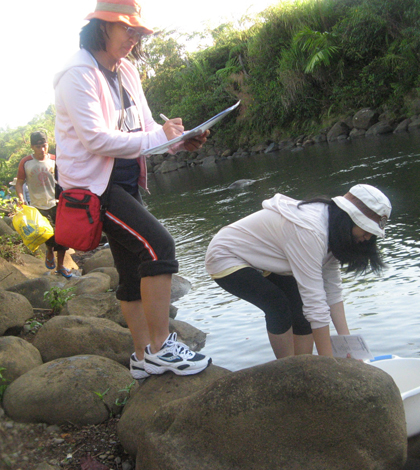Filipino researchers conduct Cagayan de Oro River’s first-ever biotic water quality assessment

The Xavier University Freshwater Biology Team at work on the Cagayan de Oro River
While probes and sensors often do a fine job of measuring water quality parameters, tiny organisms that naturally populate waterways can provide useful insight into the state of their habitat — in some cases, with greater efficiency than expensive instruments.
Researchers from the Xavier University Freshwater Biology Team in the Philippines have penned a study touting the benefits of employing riverine biota as indicators of riverine system health. Biological monitoring, they say, can be less expensive and more accurate than instrument-based methods.
“It is a human right to have access to clean water, and yet in our region there are still a lot of rivers and lakes whose status is not yet assessed,” said Astrid Sinco, research coordinator at Xavier University and diatom specialist.
That was the case with the Cagayan de Oro River, the biggest river in Cagayan de Oro City and an environmentally and economically significant waterway. Although several unpublished studies examined the health of the river, none had ever used biota as indicators.
The researchers established 16 sampling sites at key points along the river, a task that was far from easy. For the researchers, the average day began at 2 a.m. and ended at 5 p.m. Sinco recalled “panting while climbing or descending steep riverbanks,” and “wading the rivers under the scorching heat of the sun.” Some of the sites were located in the hinterlands, where the presence of political rebels created an unnerving atmosphere for research.

Putting the kick nets to work on the Cagayan de Oro River (Credit: Xavier University Freshwater Biology Team)
A variety of macroinvertebrates, diatoms and coliform bacteria live in rivers and other waterways. Water quality tolerance differs from organism to organism, so scientists can extrapolate levels of pollution, siltation and overall biological integrity from the relative abundances of species in a water sample.
Led by macroinvertebrate specialist Leolinda Saab, the researchers gathered macroinvertebrate samples with kick nets. At each site, they literally kicked up stream substrate to dislodge hidden organisms, which then floated into a net just 1 meter downstream. Algal diatoms were collected from the bottom of stones with a toothbrush and delimiter, while coliforms were gathered in water sampling bottles under the guidance of researchers Judy Sendaydiego and Giovanni Tampus.
Monitoring riverine biota has a few inherent advantages over traditional instrument-based methods of pollution detection. For starters, it can be significantly cheaper than using sensor technology. In some places, this technology may not be available at all. The study also suggests that while sensors provide only a snapshot of riverine conditions, biological monitoring relies on indicator organisms that inhabit an area for extended periods, making their presence or absence more telling of long-term water quality.
“In tropical climates such as the Philippines, heavy rainfall occurs often that causes dilution and flushing of water contaminants,” Sinco said. “The use of sensors in this case may miss the prevailing concentration [which] may be recorded by the accumulator biota.”

The biology team conducted the first health assessment for the biggest river in Cagayan de Oro City (Credit: Xavier University Freshwater Biology Team)
To validate the biological monitoring methods, the researchers had to conduct parallel sampling with traditional instruments. But reagents necessary for sensor sampling were unavailable in the Philippines, and an order from Germany arrived late, causing delays in the research. High-magnification stereo microscopes were also unavailable in the researchers’ labs, Sinco said.
While the research focused on one Filipino river, Sinco asserted that biological water monitoring can be conducted in lakes and oceans as well. The method is already being used in parts of the U.S. and Europe to considerable success.




0 comments